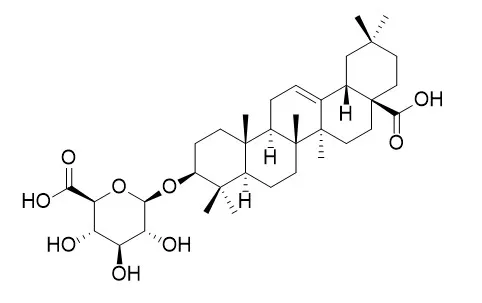| Kinase Assay: |
| Nan Fang Yi Ke Da Xue Xue Bao. 2019 Aug 30;39(8):904-910. | | Calenduloside E inhibits lipopolysaccharide-induced inflammatory response by inhibiting activation of ROS-mediated JAK1-stat3 signaling pathway in RAW264.7 cells.[Pubmed: 31511209 ] |
To investigate the effect of Calenduloside E on lipopolysaccharide (LPS)-induced inflammatory response in RAW264.7 cells and explore the underlying molecular mechanism.
METHODS AND RESULTS:
CCK-8 assay was used to examine the effect of different concentrations of Calenduloside E (0-30 μg/mL) on the viability of RAW264.7 cells. The release of the pro-inflammatory cytokines tumor necrosis factor-α (TNF-α) and interleukin-1β (IL-1β) in RAW264.7 cells in response to pretreatment with 6, 8, and 10 μg/mL Calenduloside E for 2 h followed by stimulation with 100 ng/mL LPS was detected using enzyme-linked immunosorbent assay (ELISA). The expression levels of iNOS and COX-2 and the activation of JAK-stats, MAPKs and NF-кB signaling pathways in the treated cells were determined using Western blotting. A reactive oxygen species (ROS) detection kit was used to detect ROS production in the cells, and the nuclear translocation of the transcription factor stat3 was observed by laser confocal microscopy.
Calenduloside E below 20 μg/mL did not significantly affect the viability of RAW264.7 cells. Calenduloside E dose-dependently decreased the expression levels of iNOS and COX-2 induced by LPS, inhibited LPS-induced release of TNF-α and IL-1β, and suppressed LPS-induced JAK1-stat3 signaling pathway activation and stat3 nuclear translocation. Calenduloside E also significantly reduced ROS production induced by LPS in RAW264.7 cells.
CONCLUSIONS:
Calenduloside E inhibits LPS-induced inflammatory response by blocking ROS-mediated activation of JAK1-stat3 signaling pathway in RAW264.7 cells. | | Front Pharmacol. 2018 May 23;9:532. | | Targets Fishing and Identification of Calenduloside E as Hsp90AB1: Design, Synthesis, and Evaluation of Clickable Activity-Based Probe.[Pubmed: 29875664 ] | Calenduloside E (CE), a natural triterpenoid compound isolated from Aralia elata, can protect against ox-LDL-induced human umbilical vein endothelial cell (HUVEC) injury in our previous reports. However, the exact targets and mechanisms of CE remain elusive.
METHODS AND RESULTS:
For the sake of resolving this question, we designed and synthesized a clickable activity-based probe (CE-P), which could be utilized to fish the functional targets in HUVECs using a gel-based strategy. Based on the previous studies of the structure-activity relationship (SAR), we introduced an alkyne moiety at the C-28 carboxylic group of CE, which kept the protective and anti-apoptosis activity. Via proteomic approach, one of the potential proteins bound to CE-P was identified as Hsp90AB1, and further verification was performed by pure recombinant Hsp90AB1 and competitive assay. These results demonstrated that CE could bind to Hsp90AB1. We also found that CE could reverse the Hsp90AB1 decrease after ox-LDL treatment. To make our results more convincing, we performed SPR analysis and the affinity kinetic assay showed that CE/CE-P could bind to Hsp90AB1 in a dose-dependent manner.
CONCLUSIONS:
Taken together, our research showed CE could probably bind to Hsp90AB1 to protect the cell injury, which might provide the basis for the further exploration of its cardiovascular protective mechanisms. For the sake of resolving this question, we designed and synthesized a clickable activity-based probe (CE-P), which could be utilized to fish the functional targets in HUVECs using a gel-based strategy. |
|






 Cell. 2018 Jan 11;172(1-2):249-261.e12. doi: 10.1016/j.cell.2017.12.019.IF=36.216(2019)
Cell. 2018 Jan 11;172(1-2):249-261.e12. doi: 10.1016/j.cell.2017.12.019.IF=36.216(2019) Cell Metab. 2020 Mar 3;31(3):534-548.e5. doi: 10.1016/j.cmet.2020.01.002.IF=22.415(2019)
Cell Metab. 2020 Mar 3;31(3):534-548.e5. doi: 10.1016/j.cmet.2020.01.002.IF=22.415(2019) Mol Cell. 2017 Nov 16;68(4):673-685.e6. doi: 10.1016/j.molcel.2017.10.022.IF=14.548(2019)
Mol Cell. 2017 Nov 16;68(4):673-685.e6. doi: 10.1016/j.molcel.2017.10.022.IF=14.548(2019)